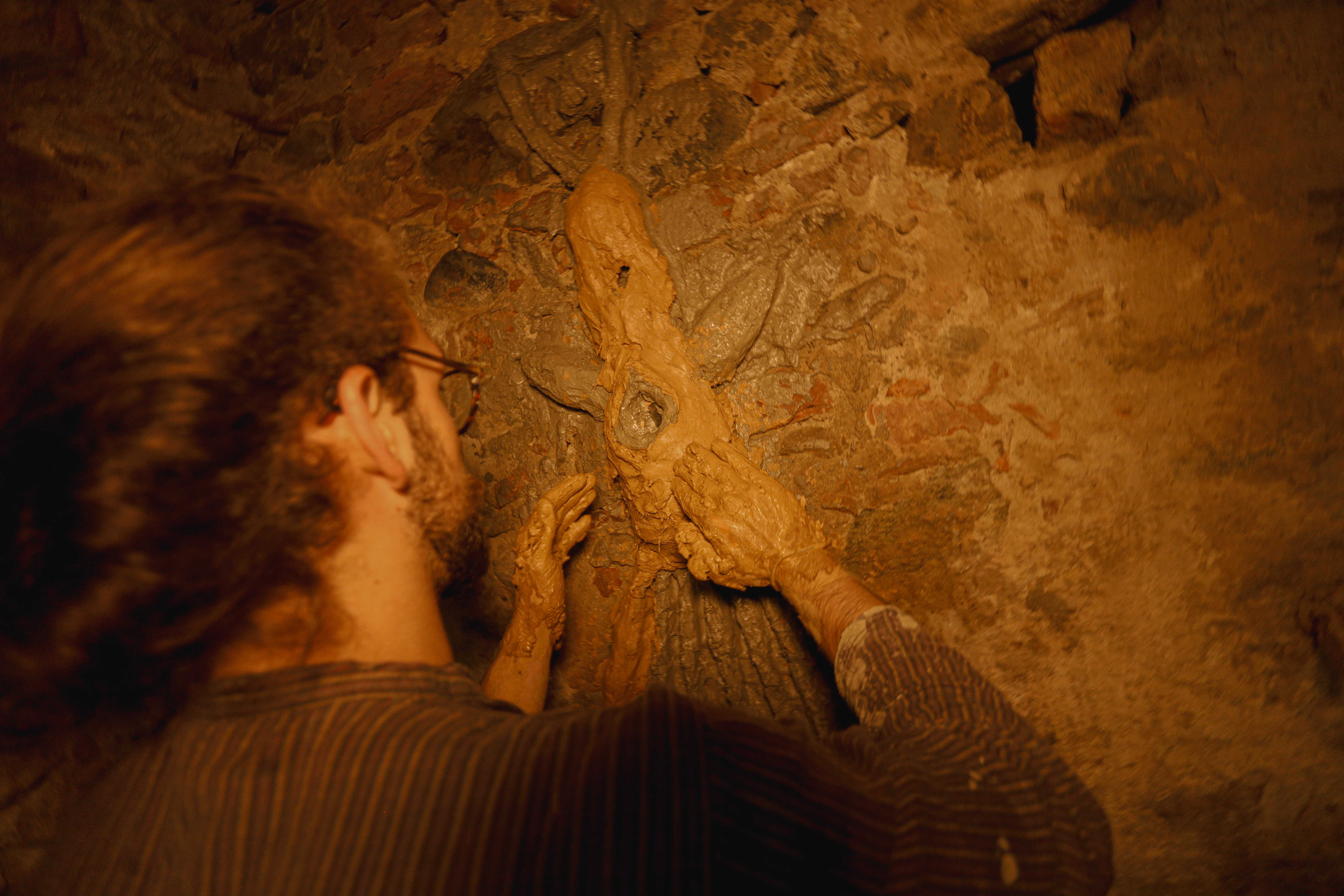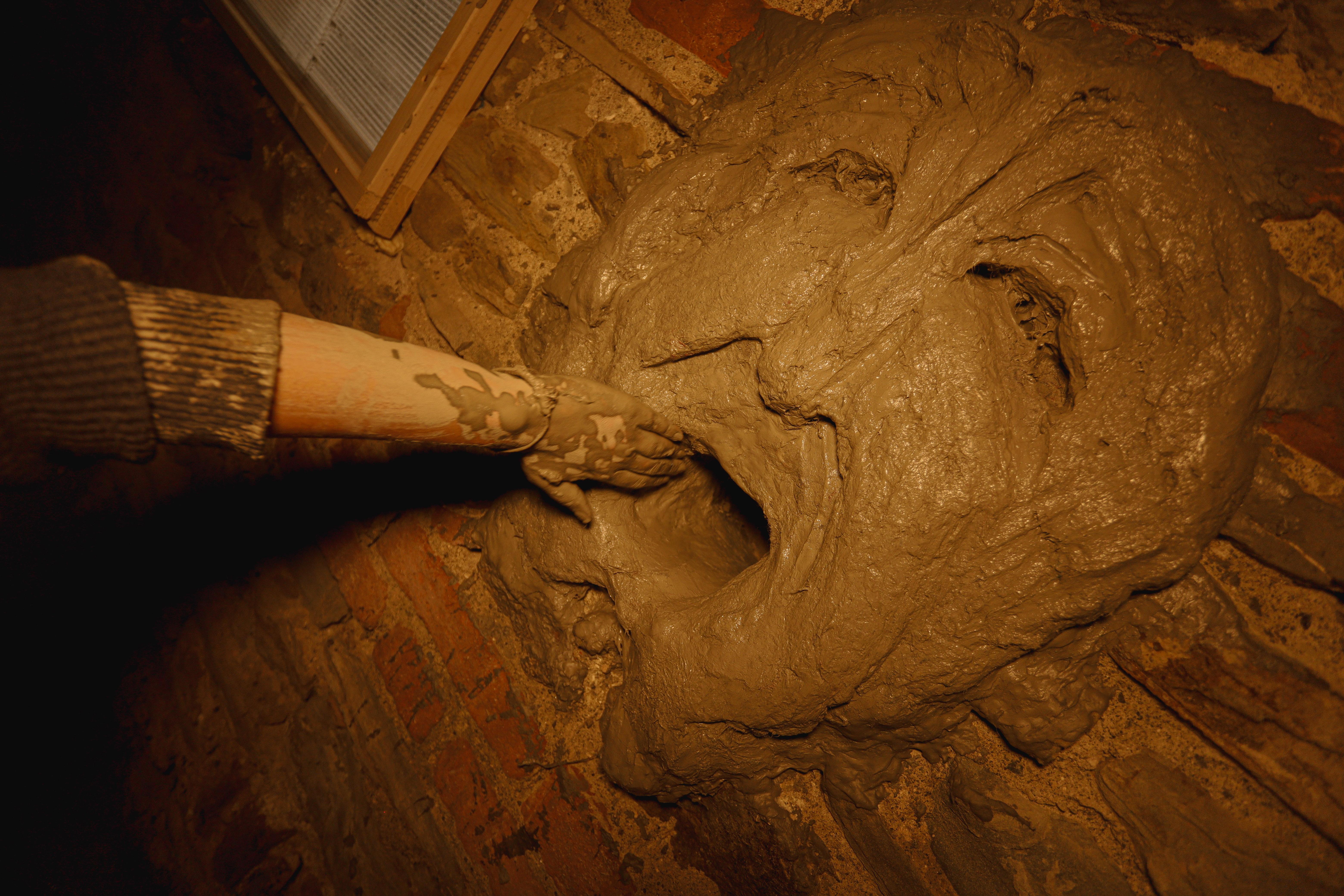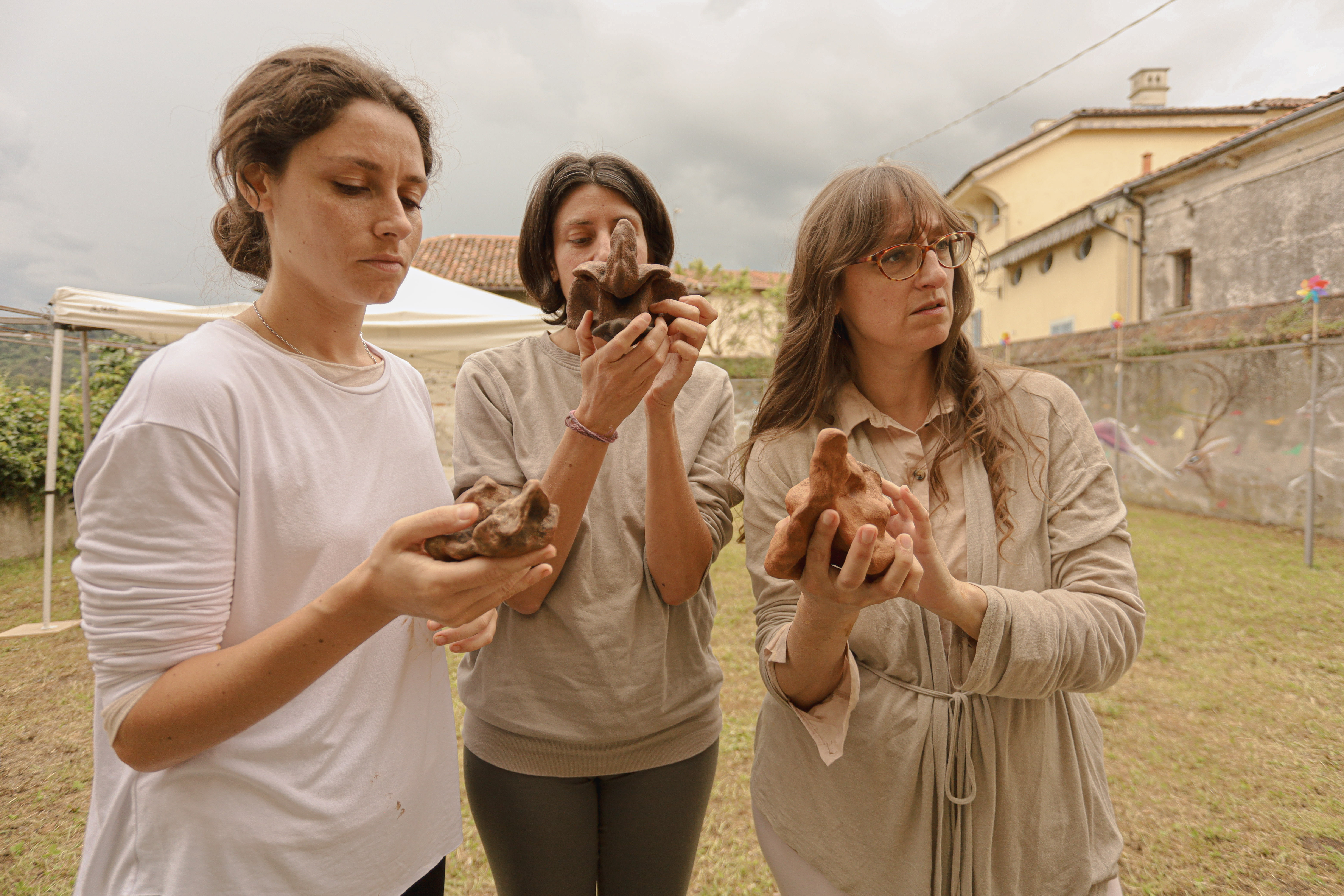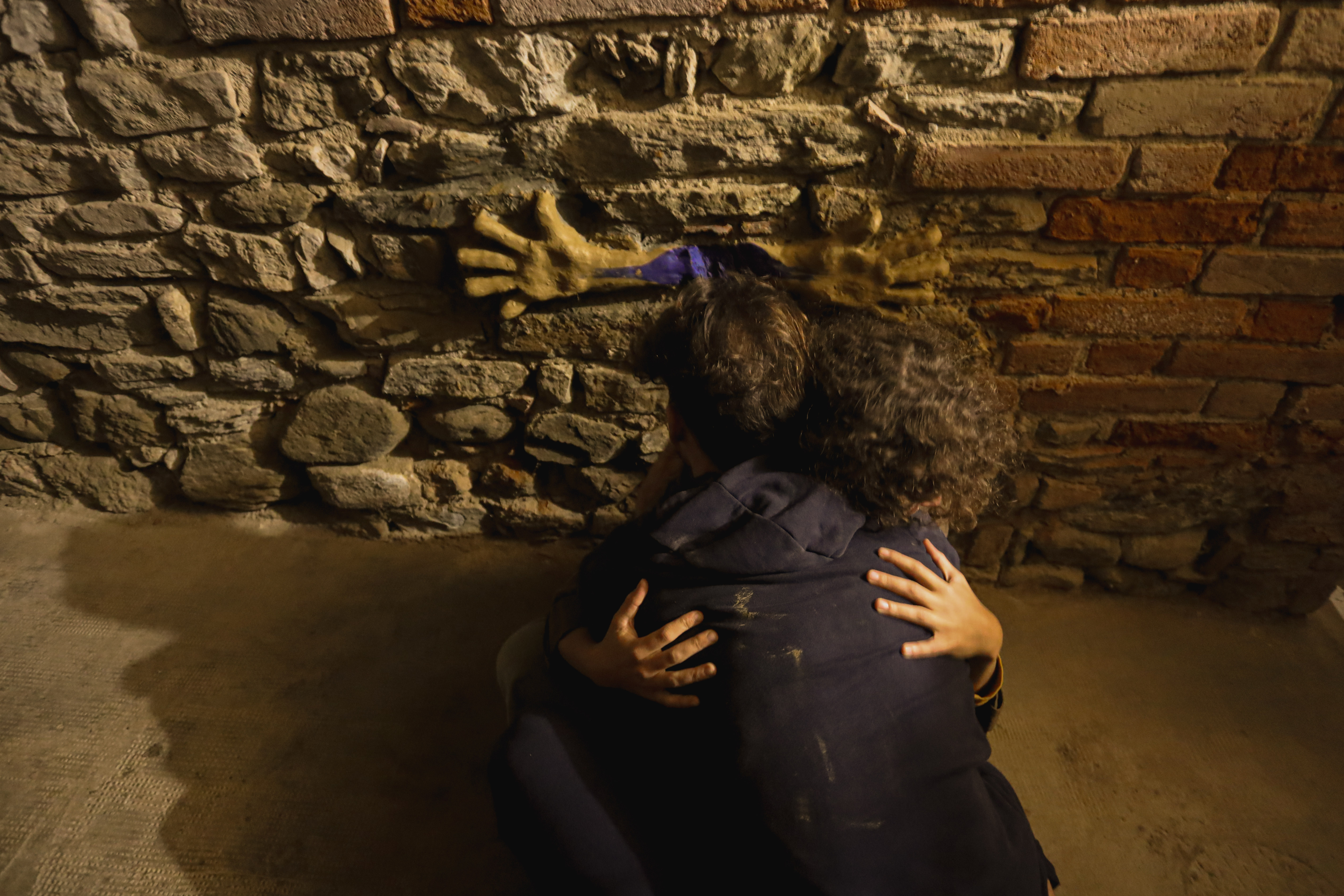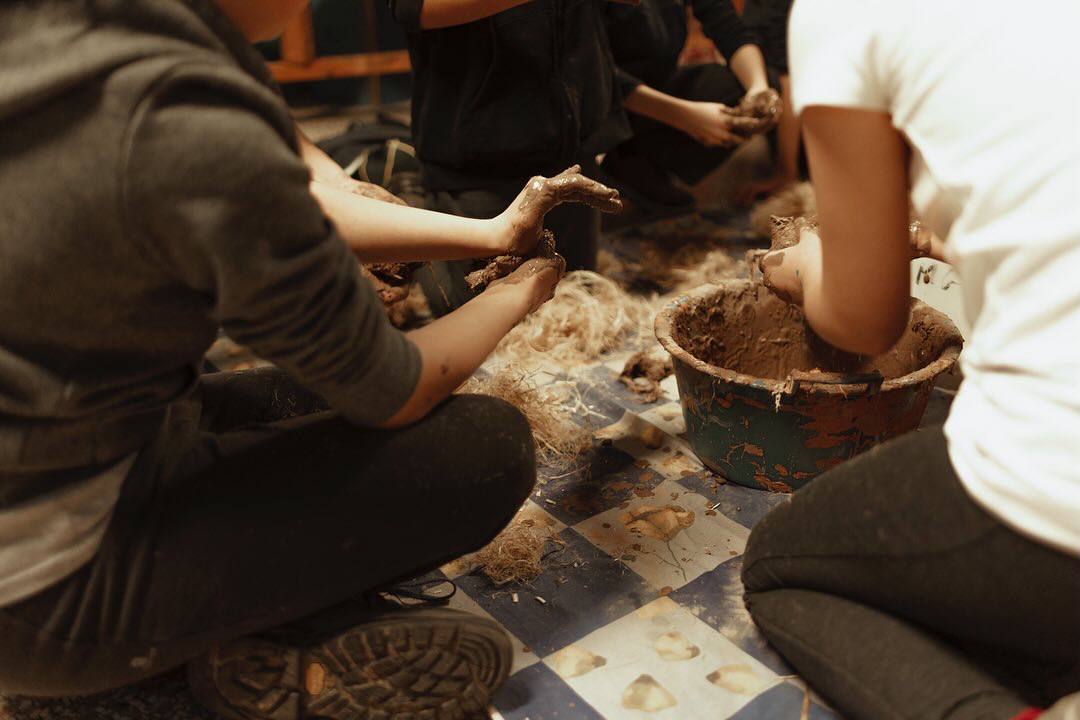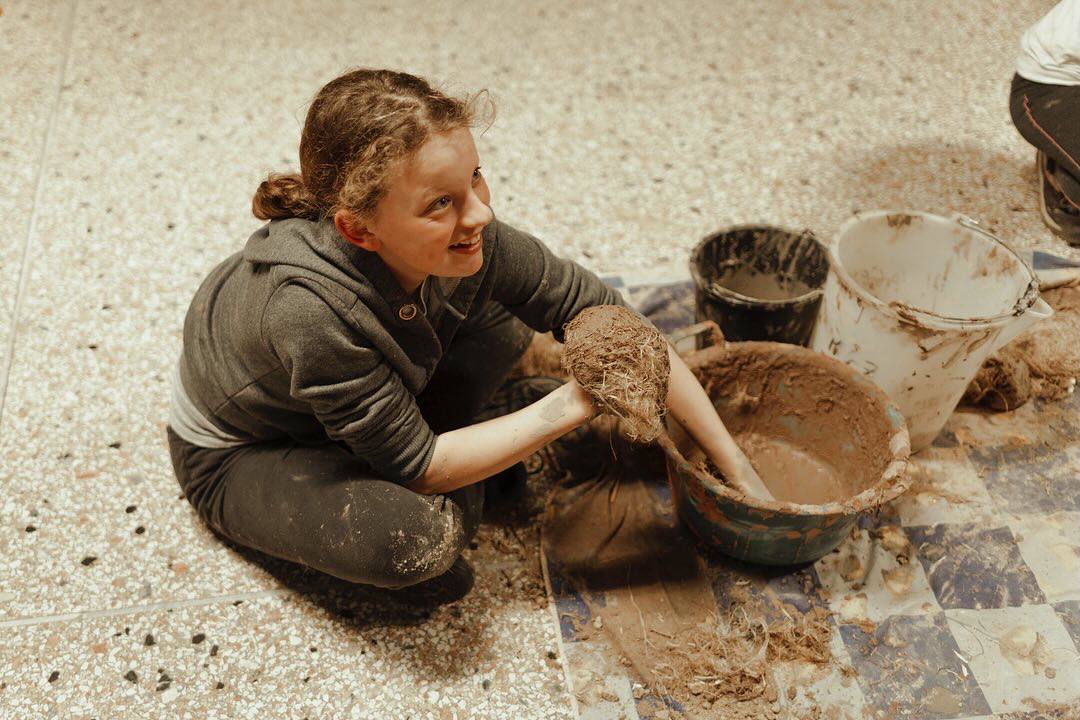Reconnecting with nature
Therapeutic sculpture
Therapeutic sculpture and ecoartivism
Through participatory sculpture, I foster personal growth and a deeper connection to nature and community. My work transforms creativity into a catalyst for change, inviting people to explore themselves and the world through hands-on artistic experiences. By merging sculpture, education, and emotional exploration, I create workshops and projects that inspire reconnection and transformation
Italy
National
Mainly rural
It refers to other types of transformations (soft investment)
Prototype level
No
No
As an individual
My work integrates sculpture, nature, and emotional exploration to foster personal growth and environmental awareness. Through participatory art, I create interactive experiences that reconnect individuals with themselves, their communities, and the natural world.
Overall Aim:
To use sculpture as a transformative tool for self-discovery, social engagement, and ecological consciousness, fostering a deeper relationship between people and their environment.
Target Group(s):
Individuals seeking personal growth and emotional well-being;
Communities interested in collective artistic experiences;
Educators and students exploring alternative learning methods;
Organizations promoting sustainability, mental health, and social cohesion.
Specific Objectives:
Facilitate hands-on workshops where participants engage in sculptural creation as a means of self-expression and reflection;
Develop site-specific installations that highlight environmental themes and invite public interaction;
Bridge art, education, and ecology through collaborative projects with schools, cultural institutions, and local communities;
Encourage emotional resilience and social bonding through creative exploration.
Achieved Outcomes:
Increased awareness of the connection between art, nature, and well-being;
Strengthened community ties through collective artistic expression;
Empowerment of individuals through hands-on creative processes;
Lasting impact through public art pieces and workshop experiences that inspire sustainable engagement with the environment.
Overall Aim:
To use sculpture as a transformative tool for self-discovery, social engagement, and ecological consciousness, fostering a deeper relationship between people and their environment.
Target Group(s):
Individuals seeking personal growth and emotional well-being;
Communities interested in collective artistic experiences;
Educators and students exploring alternative learning methods;
Organizations promoting sustainability, mental health, and social cohesion.
Specific Objectives:
Facilitate hands-on workshops where participants engage in sculptural creation as a means of self-expression and reflection;
Develop site-specific installations that highlight environmental themes and invite public interaction;
Bridge art, education, and ecology through collaborative projects with schools, cultural institutions, and local communities;
Encourage emotional resilience and social bonding through creative exploration.
Achieved Outcomes:
Increased awareness of the connection between art, nature, and well-being;
Strengthened community ties through collective artistic expression;
Empowerment of individuals through hands-on creative processes;
Lasting impact through public art pieces and workshop experiences that inspire sustainable engagement with the environment.
nature
creativity
intergenerationality
community
hands
My project integrates land art, environmental consciousness, and emotional well-being to promote sustainability on multiple levels—ecological, social, and personal. Through participatory art, I encourage a deeper, lasting connection between individuals, communities, and the natural world.
Environmental Sustainability
Objective: Use natural, recycled, and locally sourced materials to minimize environmental impact and raise awareness of sustainable artistic practices.
Achievement: I have implemented site-specific installations and workshops that emphasize ecological responsibility, using materials like clay, wood, and repurposed waste. These projects foster a direct relationship with nature and encourage sustainable creative processes.
Social Sustainability
Objective: Strengthen community engagement through collective artistic experiences that promote social cohesion and shared responsibility for the environment.
Achievement: My workshops bring together diverse groups—local communities, educators, and organizations—creating inclusive spaces for dialogue and collaboration. These initiatives empower participants to take an active role in sustainability efforts within their communities.
Personal, Emotional Sustainability
Objective: Use sculpture as a tool for emotional resilience and mental well-being, fostering long-term personal sustainability.
Achievement: By integrating artistic expression with emotional exploration, my projects help individuals reconnect with themselves, reducing stress and promoting mindfulness. Participants report a greater sense of balance and connection with their surroundings.
Exemplary aspects of the Project
Holistic Approach: Combines environmental awareness, community engagement, and personal well-being in a unique, participatory format.
Long-Term Impact: The installations and workshops inspire continued reflection and action, motivating individuals to integrate sustainability into their daily lives.
Environmental Sustainability
Objective: Use natural, recycled, and locally sourced materials to minimize environmental impact and raise awareness of sustainable artistic practices.
Achievement: I have implemented site-specific installations and workshops that emphasize ecological responsibility, using materials like clay, wood, and repurposed waste. These projects foster a direct relationship with nature and encourage sustainable creative processes.
Social Sustainability
Objective: Strengthen community engagement through collective artistic experiences that promote social cohesion and shared responsibility for the environment.
Achievement: My workshops bring together diverse groups—local communities, educators, and organizations—creating inclusive spaces for dialogue and collaboration. These initiatives empower participants to take an active role in sustainability efforts within their communities.
Personal, Emotional Sustainability
Objective: Use sculpture as a tool for emotional resilience and mental well-being, fostering long-term personal sustainability.
Achievement: By integrating artistic expression with emotional exploration, my projects help individuals reconnect with themselves, reducing stress and promoting mindfulness. Participants report a greater sense of balance and connection with their surroundings.
Exemplary aspects of the Project
Holistic Approach: Combines environmental awareness, community engagement, and personal well-being in a unique, participatory format.
Long-Term Impact: The installations and workshops inspire continued reflection and action, motivating individuals to integrate sustainability into their daily lives.
By integrating aesthetics, sensory engagement and participatory practices, I aim to provide meaningful interactions with art that foster deep reflection and connection.
Objectives, Achievements:
Objective: To create visually integrating, site-specific sculptures that harmonise with the natural landscape and enhance public spaces.
Achievements: My installations use organic forms, natural textures and sustainable materials to create works that blend seamlessly with their surroundings. Each piece is designed to invite contemplation and interaction, making art an integral part of the environment.
Quality of experience:
Objective: To provide immersive, multi-sensory experiences that involve touch, sight and movement, making art accessible and interactive.
Achievement: My workshops and installations encourage hands-on participation, allowing people to shape, feel and contribute to the artwork. This fosters a deeper emotional connection and transforms passive viewers into active creators.
Cultural, educational impact:
Objective: To use art as a bridge between tradition and contemporary discourse, fostering cultural awareness and collective memory.
Achievements: My projects incorporate storytelling, local history and ecological themes, creating a dialogue between past and present. By involving communities in the creative process, the artworks become shared cultural landmarks.
Exemplary aspects of the project:
Inclusive and engaging;
Lasting cultural value.
Objectives, Achievements:
Objective: To create visually integrating, site-specific sculptures that harmonise with the natural landscape and enhance public spaces.
Achievements: My installations use organic forms, natural textures and sustainable materials to create works that blend seamlessly with their surroundings. Each piece is designed to invite contemplation and interaction, making art an integral part of the environment.
Quality of experience:
Objective: To provide immersive, multi-sensory experiences that involve touch, sight and movement, making art accessible and interactive.
Achievement: My workshops and installations encourage hands-on participation, allowing people to shape, feel and contribute to the artwork. This fosters a deeper emotional connection and transforms passive viewers into active creators.
Cultural, educational impact:
Objective: To use art as a bridge between tradition and contemporary discourse, fostering cultural awareness and collective memory.
Achievements: My projects incorporate storytelling, local history and ecological themes, creating a dialogue between past and present. By involving communities in the creative process, the artworks become shared cultural landmarks.
Exemplary aspects of the project:
Inclusive and engaging;
Lasting cultural value.
My project is based on accessibility, participation and collective creation, ensuring that art becomes an inclusive and empowering experience for all. I create spaces where people from diverse backgrounds can connect, express themselves and engage with sustainability through artistic practice.
Accessibility, affordability
Objective: To make arts experiences open and accessible to all, regardless of economic status, physical ability or artistic background.
Achievement: My workshops and installations are designed for broad participation, using low-cost or natural materials and ensuring physical accessibility in public or community spaces. This removes financial and logistical barriers, making art an inclusive means of expression.
Collaborative approach
Objective: To promote co-creation by involving diverse groups in the artistic process, valuing multiple perspectives and lived experiences.
Achievement: My projects bring together people from different social, cultural and generational backgrounds, encouraging active participation and shared authorship. This fosters a sense of ownership and strengthens social bonds within communities.
Inclusivity
Objective: To ensure that the artistic experience is inclusive in its design, taking into account sensory, cognitive and mobility needs.
Achievement: My installations and workshops prioritise multi-sensory engagement, allowing participants to experience art through touch, movement and interaction. The formats are adaptable to different abilities, making them accessible to people with different needs.
New social models, inclusive governance
Objective: To promote alternative models of community-driven arts and decision-making, where culture is co-created rather than imposed.
Achievement: By involving local communities, educators and organisations in the planning and delivery of projects, I promote horizontal governance, ensuring that culture is collectively shaped.
Accessibility, affordability
Objective: To make arts experiences open and accessible to all, regardless of economic status, physical ability or artistic background.
Achievement: My workshops and installations are designed for broad participation, using low-cost or natural materials and ensuring physical accessibility in public or community spaces. This removes financial and logistical barriers, making art an inclusive means of expression.
Collaborative approach
Objective: To promote co-creation by involving diverse groups in the artistic process, valuing multiple perspectives and lived experiences.
Achievement: My projects bring together people from different social, cultural and generational backgrounds, encouraging active participation and shared authorship. This fosters a sense of ownership and strengthens social bonds within communities.
Inclusivity
Objective: To ensure that the artistic experience is inclusive in its design, taking into account sensory, cognitive and mobility needs.
Achievement: My installations and workshops prioritise multi-sensory engagement, allowing participants to experience art through touch, movement and interaction. The formats are adaptable to different abilities, making them accessible to people with different needs.
New social models, inclusive governance
Objective: To promote alternative models of community-driven arts and decision-making, where culture is co-created rather than imposed.
Achievement: By involving local communities, educators and organisations in the planning and delivery of projects, I promote horizontal governance, ensuring that culture is collectively shaped.
The involvement of citizens and civil society is central to my project. Citizens are not just recipients of art, but active contributors to its creation, ensuring that the project reflects their perspectives and needs.
Co-creation and collaboration
Role: Citizens from diverse backgrounds, including local residents, educators, artists and community groups, are directly involved in the creative process through workshops, discussions and collaborative installations.
Level of involvement: High, as participants engage not only with the art, but also as co-creators, influencing the final outcome with their experiences, cultural knowledge and creativity.
Workshops and community engagement
Role: Local people participate in hands-on workshops, interacting with materials, the environment and each other. These workshops promote shared ownership and collective responsibility, making the community an integral part of the project's development.
Level of involvement: The workshops are inclusive, ensuring that everyone, regardless of age, background or ability, can contribute. This creates an open space for dialogue and collective artistic expression.
Feedback and reflection
Role: Citizens are encouraged to provide feedback on the process and the impact of the art on their lives and communities, influencing the development of the project.
Level of involvement: Feedback is gathered through conversations, surveys and open discussions, strengthening the sense of community and ensuring that the project remains relevant.
Impact of community involvement:
Cultural enrichment and social cohesion
Active participation enriches the cultural significance of the project, as the artworks reflect the identities, histories and values of the community, fostering social cohesion.
In summary, citizens' involvement makes them protagonists in the creation of art and culture, meaningfully shaping the project and fostering community bonds.
Co-creation and collaboration
Role: Citizens from diverse backgrounds, including local residents, educators, artists and community groups, are directly involved in the creative process through workshops, discussions and collaborative installations.
Level of involvement: High, as participants engage not only with the art, but also as co-creators, influencing the final outcome with their experiences, cultural knowledge and creativity.
Workshops and community engagement
Role: Local people participate in hands-on workshops, interacting with materials, the environment and each other. These workshops promote shared ownership and collective responsibility, making the community an integral part of the project's development.
Level of involvement: The workshops are inclusive, ensuring that everyone, regardless of age, background or ability, can contribute. This creates an open space for dialogue and collective artistic expression.
Feedback and reflection
Role: Citizens are encouraged to provide feedback on the process and the impact of the art on their lives and communities, influencing the development of the project.
Level of involvement: Feedback is gathered through conversations, surveys and open discussions, strengthening the sense of community and ensuring that the project remains relevant.
Impact of community involvement:
Cultural enrichment and social cohesion
Active participation enriches the cultural significance of the project, as the artworks reflect the identities, histories and values of the community, fostering social cohesion.
In summary, citizens' involvement makes them protagonists in the creation of art and culture, meaningfully shaping the project and fostering community bonds.
Stakeholder engagement contributed to the success of the project, ensuring local relevance and global impact.
Local stakeholders:
Role, Involvement: Local citizens and groups were actively involved in the design process through workshops and discussions.
Added value: They contributed to the cultural relevance of the project, fostering a strong sense of ownership and sustainability.
Regional stakeholders:
Role, involvement: Regional institutions and local governments supported infrastructure and promotion.
Added value: They ensured visibility and scalability within the region.
National stakeholders:
Role, involvement: National institutions provided funding and strategic support.
Added value: They provided resources, visibility and alignment with national cultural policies.
Stakeholder involvement enriched the project, ensuring local relevance, scalability and sustainable cultural impact.
Local stakeholders:
Role, Involvement: Local citizens and groups were actively involved in the design process through workshops and discussions.
Added value: They contributed to the cultural relevance of the project, fostering a strong sense of ownership and sustainability.
Regional stakeholders:
Role, involvement: Regional institutions and local governments supported infrastructure and promotion.
Added value: They ensured visibility and scalability within the region.
National stakeholders:
Role, involvement: National institutions provided funding and strategic support.
Added value: They provided resources, visibility and alignment with national cultural policies.
Stakeholder involvement enriched the project, ensuring local relevance, scalability and sustainable cultural impact.
My project brings together several disciplines to create a holistic, interdisciplinary approach to art, sustainability and community engagement.
Sculpture, performance and video art: Rooted in creativity, the project emphasises hands-on craftsmanship and the use of sustainable materials. It engages diverse communities in collective performance, land art and video installation, linking creativity with local context and environmental issues.
Sustainability: Sustainability was a guiding principle, influencing the choice of materials - natural, recyclable and biodegradable - and the project's focus on environmental issues and climate change.
Community Development, Social Sciences, Psychology: The project emphasises social inclusion and active participation, drawing on community development theories. It has promoted dialogue and collective ownership through workshops and community art-making. Social scientists, psychologists, researchers and community organisers have played a key role in supporting inclusive processes.
Education and pedagogy: An educational aspect was integrated through interactive workshops and discussions to promote learning about sustainability, culture and art.
Interdisciplinary interaction: The different disciplines interacted and enriched each other through workshops, joint discussions and shared decision-making.
Added value: The interdisciplinary approach strengthened the project by bringing together artistic expression, environmental responsibility and community engagement. This collaboration has driven innovation and resulted in a sustainable, meaningful experience that promotes art and learning,
Sculpture, performance and video art: Rooted in creativity, the project emphasises hands-on craftsmanship and the use of sustainable materials. It engages diverse communities in collective performance, land art and video installation, linking creativity with local context and environmental issues.
Sustainability: Sustainability was a guiding principle, influencing the choice of materials - natural, recyclable and biodegradable - and the project's focus on environmental issues and climate change.
Community Development, Social Sciences, Psychology: The project emphasises social inclusion and active participation, drawing on community development theories. It has promoted dialogue and collective ownership through workshops and community art-making. Social scientists, psychologists, researchers and community organisers have played a key role in supporting inclusive processes.
Education and pedagogy: An educational aspect was integrated through interactive workshops and discussions to promote learning about sustainability, culture and art.
Interdisciplinary interaction: The different disciplines interacted and enriched each other through workshops, joint discussions and shared decision-making.
Added value: The interdisciplinary approach strengthened the project by bringing together artistic expression, environmental responsibility and community engagement. This collaboration has driven innovation and resulted in a sustainable, meaningful experience that promotes art and learning,
The innovative nature of my project lies in the seamless integration of art, sustainability and community engagement through an interdisciplinary and participatory approach, as opposed to traditional methods that often treat these elements separately.
Holistic approach: Unlike mainstream projects that may focus on a single medium or perspective, my project brings together different disciplines to create a comprehensive experience. This multifaceted approach allows for a deeper exploration of the intersections between creativity, sustainability and community dynamics.
Sustainability as a core principle: While many art projects incorporate sustainability as a secondary concern, my project places environmental responsibility at the heart of the creative process. The use of natural, recyclable and biodegradable materials isn't just a choice, but a deliberate response to pressing global issues such as climate change and conservation, combining artistic expression with environmental awareness.
Collaborative co-creation: The project is rooted in active participation, where citizens - rather than mere observers - become co-creators. This collaborative model differs from traditional art exhibitions, where artists remain the primary creators and the public is passive.
Community and social engagement: This project prioritises social inclusion by using art as a tool for dialogue and collective identity building. It challenges the conventional view of art as an isolated, elite experience, instead making it a platform for marginalised voices and active participation.
Educational integration: Education is not an add-on but a core component. Through workshops and discussions, the project facilitates hands-on learning about sustainability, cultural heritage and artistic practices. In this way, the artistic process itself becomes a vehicle for education, bridging the gap between artistic practice and social impact.
Holistic approach: Unlike mainstream projects that may focus on a single medium or perspective, my project brings together different disciplines to create a comprehensive experience. This multifaceted approach allows for a deeper exploration of the intersections between creativity, sustainability and community dynamics.
Sustainability as a core principle: While many art projects incorporate sustainability as a secondary concern, my project places environmental responsibility at the heart of the creative process. The use of natural, recyclable and biodegradable materials isn't just a choice, but a deliberate response to pressing global issues such as climate change and conservation, combining artistic expression with environmental awareness.
Collaborative co-creation: The project is rooted in active participation, where citizens - rather than mere observers - become co-creators. This collaborative model differs from traditional art exhibitions, where artists remain the primary creators and the public is passive.
Community and social engagement: This project prioritises social inclusion by using art as a tool for dialogue and collective identity building. It challenges the conventional view of art as an isolated, elite experience, instead making it a platform for marginalised voices and active participation.
Educational integration: Education is not an add-on but a core component. Through workshops and discussions, the project facilitates hands-on learning about sustainability, cultural heritage and artistic practices. In this way, the artistic process itself becomes a vehicle for education, bridging the gap between artistic practice and social impact.
The methodology of my project is interdisciplinary, participatory and community-centred, combining art, sustainability and social engagement.
Interdisciplinary integration: The project combines sculpture, performance, video art, environmental science, social science, education and psychology to create a comprehensive experience that addresses both cultural and environmental issues.
Community engagement and co-creation: Citizens of all ages and backgrounds are actively involved in the creative process through workshops, performances and art installations, fostering ownership and inclusivity.
Sustainability: Sustainability is a core principle, guiding the choice of eco-friendly materials and addressing environmental concerns such as climate change and conservation.
Educational component: Workshops and art experiences provide learning opportunities on sustainability, cultural heritage and artistic practices, bridging art and social impact.
Collaborative decision-making: Stakeholders, including the artist, community members and experts, collaborate on decisions to ensure that the project reflects diverse perspectives and needs.
This approach creates a dynamic and meaningful project that is culturally relevant, environmentally responsible, socially inclusive and replicable.
Interdisciplinary integration: The project combines sculpture, performance, video art, environmental science, social science, education and psychology to create a comprehensive experience that addresses both cultural and environmental issues.
Community engagement and co-creation: Citizens of all ages and backgrounds are actively involved in the creative process through workshops, performances and art installations, fostering ownership and inclusivity.
Sustainability: Sustainability is a core principle, guiding the choice of eco-friendly materials and addressing environmental concerns such as climate change and conservation.
Educational component: Workshops and art experiences provide learning opportunities on sustainability, cultural heritage and artistic practices, bridging art and social impact.
Collaborative decision-making: Stakeholders, including the artist, community members and experts, collaborate on decisions to ensure that the project reflects diverse perspectives and needs.
This approach creates a dynamic and meaningful project that is culturally relevant, environmentally responsible, socially inclusive and replicable.
Several elements of my project could be replicated or transferred to other locations, beneficiary groups and contexts, making it adaptable and scalable while maintaining its core values. These include
Interdisciplinary methodology: The integration of art, sustainability and community engagement is adaptable to different regions.
Community co-creation: The participatory model, where local citizens become active co-creators, not just observers, is highly replicable.
Workshops and educational components: The workshops are easily transferable to different locations as they are designed to be adaptable, inclusive and educational.
Use of sustainable materials: The emphasis on the use of environmentally friendly, natural, recyclable and biodegradable materials in the project is replicable as these materials are globally available and can be used in a variety of artistic practices. This aspect ensures that the element of environmental responsibility can be incorporated into any future project.
Collaborative decision-making: The involvement of different stakeholders, from artists to community members and local organisations, is a transferable process. The decision-making model can be replicated by involving local groups, ensuring that the project reflects the needs of the community and is locally relevant.
Technology and virtual engagement: The use of digital platforms to share video art or host virtual workshops and discussions makes the project adaptable to different digital spaces, extending its reach beyond physical locations and allowing it to engage global audiences.
These elements can be adapted to different social, cultural and environmental contexts, allowing for successful replication of the project's approach, methodology and impact.
Interdisciplinary methodology: The integration of art, sustainability and community engagement is adaptable to different regions.
Community co-creation: The participatory model, where local citizens become active co-creators, not just observers, is highly replicable.
Workshops and educational components: The workshops are easily transferable to different locations as they are designed to be adaptable, inclusive and educational.
Use of sustainable materials: The emphasis on the use of environmentally friendly, natural, recyclable and biodegradable materials in the project is replicable as these materials are globally available and can be used in a variety of artistic practices. This aspect ensures that the element of environmental responsibility can be incorporated into any future project.
Collaborative decision-making: The involvement of different stakeholders, from artists to community members and local organisations, is a transferable process. The decision-making model can be replicated by involving local groups, ensuring that the project reflects the needs of the community and is locally relevant.
Technology and virtual engagement: The use of digital platforms to share video art or host virtual workshops and discussions makes the project adaptable to different digital spaces, extending its reach beyond physical locations and allowing it to engage global audiences.
These elements can be adapted to different social, cultural and environmental contexts, allowing for successful replication of the project's approach, methodology and impact.
My project addresses global challenges by providing tailored, local solutions that focus on sustainability, social inclusion and environmental awareness, using art as a catalyst for change.
Environmental sustainability and climate change:
Global Challenge: The urgent need for climate action and environmental responsibility.
Local Solution: The project integrates sustainable practices by using natural, recyclable and biodegradable materials to minimise environmental impact. It also raises awareness of local environmental issues.
Social inclusion:
Global challenge: Widespread social exclusion and inequality.
Local solution: The project actively involves diverse community members in the creative process. By fostering a sense of ownership and participation through workshops and collective art-making, it promotes social cohesion and empowers marginalised groups.
Cultural engagement:
Global Challenge: The disconnect between the arts and underrepresented communities.
Local solution: The project transforms art from an elite, passive experience into an inclusive, active one.
Education for Sustainability:
Global Challenge: The need for a better understanding of sustainability and its everyday impact.
Local Solution: Through interactive workshops, the project educates participants about sustainability, climate change and cultural heritage. Art becomes a tool for learning, linking complex global issues with local action.
Community resilience:
A global challenge: Many communities struggle with resilience in the face of environmental or social challenges.
Local solution: The participatory nature of the project strengthens local resilience by encouraging collaboration and collective problem-solving, enabling communities to address issues together and build long-term sustainability.
This approach provides local solutions to global problems and offers a model that can be adapted and replicated in different contexts around the world.
Environmental sustainability and climate change:
Global Challenge: The urgent need for climate action and environmental responsibility.
Local Solution: The project integrates sustainable practices by using natural, recyclable and biodegradable materials to minimise environmental impact. It also raises awareness of local environmental issues.
Social inclusion:
Global challenge: Widespread social exclusion and inequality.
Local solution: The project actively involves diverse community members in the creative process. By fostering a sense of ownership and participation through workshops and collective art-making, it promotes social cohesion and empowers marginalised groups.
Cultural engagement:
Global Challenge: The disconnect between the arts and underrepresented communities.
Local solution: The project transforms art from an elite, passive experience into an inclusive, active one.
Education for Sustainability:
Global Challenge: The need for a better understanding of sustainability and its everyday impact.
Local Solution: Through interactive workshops, the project educates participants about sustainability, climate change and cultural heritage. Art becomes a tool for learning, linking complex global issues with local action.
Community resilience:
A global challenge: Many communities struggle with resilience in the face of environmental or social challenges.
Local solution: The participatory nature of the project strengthens local resilience by encouraging collaboration and collective problem-solving, enabling communities to address issues together and build long-term sustainability.
This approach provides local solutions to global problems and offers a model that can be adapted and replicated in different contexts around the world.
Steps to further develop, promote and implement the project in the year following the application include
Expansion and scaling: Expand to new regions by replicating the model, engaging new local partners and stakeholders, and adapting to different cultural and environmental contexts.
Strengthening collaborations: Establish formal partnerships with environmental experts, community organisations and institutions to extend the project's reach and expertise.
Artistic development: Continue to develop the artistic components of the project through new installations, performances and workshops. This will include participation in artist residencies and other artist research formats and spaces.
Evaluation and feedback: Evaluate the social, cultural and environmental impact of the project through surveys and discussions with participants and stakeholders. Use the feedback to refine the approach for future implementations.
Public and community engagement: Increase public participation by organising exhibitions, performances and events to showcase the results of the project and encourage ongoing community involvement.
Sustainability and funding: Securing long-term funding through grants, sponsorship and partnerships with international cultural organisations to ensure the continued growth of the project.
Documentation, Communication, Dissemination: Produce reports, documentaries and online resources to share the project's findings and methods and inspire similar initiatives in other communities and organisations.
Expansion and scaling: Expand to new regions by replicating the model, engaging new local partners and stakeholders, and adapting to different cultural and environmental contexts.
Strengthening collaborations: Establish formal partnerships with environmental experts, community organisations and institutions to extend the project's reach and expertise.
Artistic development: Continue to develop the artistic components of the project through new installations, performances and workshops. This will include participation in artist residencies and other artist research formats and spaces.
Evaluation and feedback: Evaluate the social, cultural and environmental impact of the project through surveys and discussions with participants and stakeholders. Use the feedback to refine the approach for future implementations.
Public and community engagement: Increase public participation by organising exhibitions, performances and events to showcase the results of the project and encourage ongoing community involvement.
Sustainability and funding: Securing long-term funding through grants, sponsorship and partnerships with international cultural organisations to ensure the continued growth of the project.
Documentation, Communication, Dissemination: Produce reports, documentaries and online resources to share the project's findings and methods and inspire similar initiatives in other communities and organisations.

